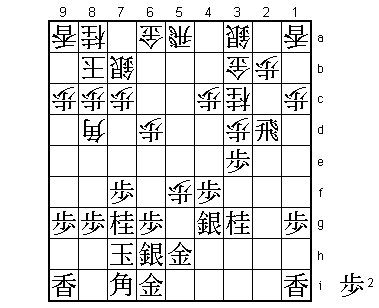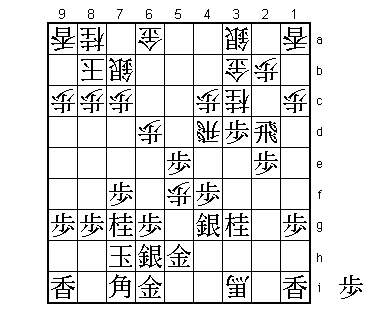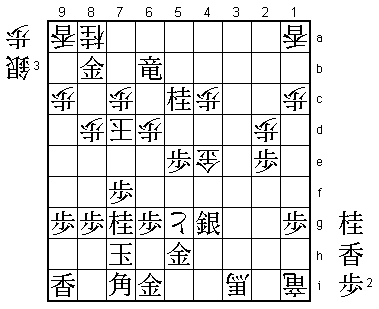52nd Oza Match Game 2
[Black "Habu Yoshiharu, Oza"]
[White "Moriuchi Toshiyuki, Challenger"]
[Event "52nd Oza-sen, Game 2"]
[Date "September 14th 2004"]
1.P7g-7f 00:00:00 00:00:00
2.P3c-3d 00:00:00 00:00:00
3.P2g-2f 00:02:00 00:00:00
4.P5c-5d 00:02:00 00:00:00
5.K5i-6h 00:05:00 00:00:00
6.P5d-5e 00:05:00 00:05:00
7.S3i-4h 00:06:00 00:05:00
8.R8b-5b 00:06:00 00:05:00
The Gokigen Nakabisha. A very popular opening, so no real surprise.
9.K6h-7h 00:06:00 00:05:00
10.K5a-6b 00:06:00 00:06:00
11.P4g-4f 00:08:00 00:06:00
12.K6b-7b 00:08:00 00:08:00
13.S4h-4g 00:08:00 00:08:00
14.K7b-8b 00:08:00 00:08:00
15.S7i-6h 00:10:00 00:08:00
16.S7a-7b 00:10:00 00:12:00
17.G4i-5h 00:14:00 00:12:00
18.P6c-6d 00:14:00 00:20:00
19.P2f-2e 00:42:00 00:20:00
20.B2b-3c 00:42:00 00:20:00
21.S4g-3f 00:42:00 00:20:00
Moving this silver up in this way is one of the latest strategies.
Black wants to attack the weak point 3d.
22.P5e-5f 00:42:00 00:26:00
23.B8hx3c+ 00:45:00 00:26:00
24.N2ax3c 00:45:00 00:26:00
25.P5gx5f 00:45:00 00:26:00
26.R5bx5f 00:45:00 00:26:00
27.P2e-2d 00:46:00 00:26:00

28.P2cx2d 00:46:00 00:43:00
In the press room often wild variations are being analyzed, just
because these are more interesting. Murayama (4-dan) proposed
29.Rx7f here. Then, if 30.S7g Rx4f P*4g R5f Px2c+ P*2g Rx2g B*4i R2h
P*2g, black is in trouble: Sx2g fails to N4e and if black plays R1h,
the white pawn on 2g becomes a thorn in his side. However, if after
R4f, black plays S4g instead of P*4g, it seems that black has the upper
hand.
29.R2hx2d 00:49:00 00:43:00
30.P*2b 00:49:00 00:43:00
31.S3f-4g 01:10:00 00:43:00
32.R5f-5a 01:10:00 00:45:00
33.P3g-3f 01:14:00 00:45:00
34.G4a-3b 01:14:00 01:01:00
35.N2i-3g 01:24:00 01:01:00
36.P*5f 01:24:00 01:35:00
37.P3f-3e 01:48:00 01:35:00
38.B*4d 01:48:00 02:43:00
39.B*7g 02:03:00 02:43:00
40.B4dx7g+ 02:03:00 02:52:00
41.N8ix7g 02:03:00 02:52:00
42.B*8d 02:03:00 02:57:00
43.B*7i! 02:20:00 02:57:00

The move that was also proposed by Morishita, probably one of the best
defenders in the game. However, the other professionals preferred
43.B*6f. However, then 44.Bx6f Px6f Px3e P*3d P3f Sx3f B*3i and the
pawn on 6f becomes a liability. Morishita reasoned as follows:
If everything else on the board is even, dropping a bishop on 7i
would be out of the question, but here black has no pawns in front
of the rook, two pawns in hand and a good attack on the head of the
knight on 3c. There is no need for black to become greedy here by wanting
to use the bishop in a perfect way as well.
44.B8d-3i+? 02:20:00 03:15:00
A big mistake caused by completely overlooking a move. White has to
play 44.P2c here, but even then 45.R2f R5d P*5e Rx5e Px3d R3e R3f Rx3f
Sx3f R*3i Px3c+ Gx3c R*4a S3b Rx1a+ is good for black. It seems that
white is already in trouble after the strong bishop drop on 7i.
45.P3ex3d 02:30:00 03:15:00
46.R5a-5d 02:30:00 03:15:00
47.P*5e 02:30:00 03:15:00
48.R5d-4d 02:30:00 03:15:00
49.P*2e! 02:31:00 03:15:00

The move Moriuchi overlooked. He probably only considered 49.P1f here,
which looks promising after 50.P2c Px3c+ Rx2d P*2e R1d P1e. However, if
white just replies 50.P6e to 49.P1f, the position is unclear. After
49.P*2e, white loses a full knight without compensation. "With one move,
the game is over" (Moriuchi).
50.P2b-2c 02:31:00 03:54:00
51.P3dx3c+ 02:43:00 03:54:00
52.P2cx2d 02:43:00 04:00:00
53.P4f-4e 02:44:00 04:00:00
54.G3bx3c 02:44:00 04:01:00
55.P4ex4d 02:44:00 04:01:00
56.P*3f 02:44:00 04:03:00
57.S4gx3f 02:57:00 04:03:00
58.R*3h 02:57:00 04:16:00
59.R*3e 03:18:00 04:16:00
60.S3a-2b 03:18:00 04:37:00
61.S3f-4g 03:25:00 04:37:00
A nice combination to save the knight. White gets no chance to get back
in the game.
62.R3h-2h+ 03:25:00 04:37:00
63.N3g-4e 03:25:00 04:37:00
64.G3cx4d 03:25:00 04:41:00
65.R3e-3b+ 03:25:00 04:41:00
66.G4dx4e 03:25:00 04:41:00
67.+R3bx2b 03:25:00 04:41:00
68.+R2hx1i 03:25:00 04:44:00
69.N*5c 03:32:00 04:44:00
70.G6a-7a 03:32:00 04:45:00
71.S*6c 03:32:00 04:45:00
72.N*5g 03:32:00 04:57:00
73.S6cx7b= 03:52:00 04:57:00
74.G7ax7b 03:52:00 04:57:00
75.S*6c 03:52:00 04:57:00
76.L*7a 03:52:00 04:57:00
77.S6cx7b= 03:55:00 04:57:00
78.L7ax7b 03:55:00 04:57:00
79.G*6b 03:55:00 04:57:00
80.P8c-8d 03:55:00 04:59:00
81.G6bx7b 03:57:00 04:59:00
82.K8b-8c 03:57:00 04:59:00
83.S6hx5g 03:57:00 04:59:00
84.P5fx5g+ 03:57:00 04:59:00
85.G7b-8b 03:57:00 04:59:00
86.K8c-7d 03:57:00 04:59:00
87.+R2b-6b 03:57:00 04:59:00
Resigns 03:57:00 04:59:00

No defence against the double mating threat N*6f and N*8f and also
no effective checks. An unusual loss for Moriuchi, who does not miss
much and is famous for giving his opponents the feeling that they are
playing against a wall. After losing the Kisei match in straight games
against Sato, he is in danger of doing the same in the Oza. On the other
hand, Habu is now on the brink of claiming his 13th consecutive Oza title.
Can Moriuchi use the long three-week break until game 3 to recover?



